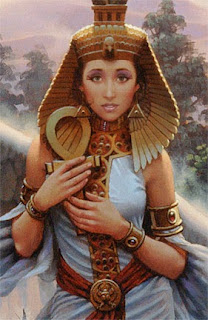Happy Mother's Day
Happy Mother's Day to all the moms around the world. Mom, they wear many hats. They are the teacher, protector, nurse, counselor, and 1st fan to name a few. Famous great mothers through history is Princess Diana, Empress Maria Theresa of Austria, Ann Maria Jarvis founder of Mother's Day to a few. There history humanity calls to the Mother or a mother goddess for protection, love and/or feeding the nation with nature's bounty. One of many mother goddess is age is Isis. The article is focused on Isis's Roman aspect.
Isis is a goddess in Ancient Egyptian religious beliefs, whose worship spread throughout the Greco-Roman world. She is worshipped as the ideal mother and wife as well as the Goddess of nature and magic. She is the friend of slaves, sinners, artisans, and the exploited, and she listened to the prayers of the wealthy, maidens, aristocrats, and rulers. Isis is the goddess of motherhood, magic and fertility.
Isis ("Aset" in the native Egyptian language) had her start as a comparatively minor deity of Egypt. She was a protector of the throne of Egypt and Royal Power. But she had been subordinate in the official Egyptian pantheon to deities more intimately connected with the great King of the Gods, like Ra and Horus. Isis is an interesting contradiction: on the one hand, she's beloved as a benevolent mother figure, lauded for her protection of children, patronage of the pharaoh and renowned dedication to her family, making her the ultimate model for every Egyptian woman to aspire to. And on the other hand, the tales of her adventures make it clear that she is also a lady with such ruthlessly crafty scheming chops that she would win the Game of Thrones in one month flat and then get on with her hobbies. (In fact, she did that, basically.) Isis is simply a social powerhouse; where other goddess influence events by using their great beauty to confuse or entice others into doing it for them, Isis gets right in there and gets her hands dirty, pulling the strings herself and never shying away from becoming the power behind the throne in a very direct and real way. She is the ultimate in love to those she cares about - and the ultimate threat to anyone else who might try to take anything away from them that she considers theirs. Stay in her good graces!
The collapse of the Old Kingdom brought about several sweeping changes in Egyptian religion. Eternal life, which had once been viewed as the sole province of the King, came to be seen as the reward for all those willing to submit to the proper cults (sound familiar). In this new paradigm Isis took center stage and became the central goddess in the popular religion of the Egyptian people.
The conquest of Egypt by Alexander opened a new era for the cult. In trying to find a religious cult that would unite both Egyptian and Hellenic subjects, Ptolemy Soter crafted the Isis cult as it would be introduced into Greco-Roman society. Osiris was renamed Serapis and identified with a variety of Greek gods (Dionysus, Helios, Hades). He became a god of healing and the underworld. Isis was identified with Demeter or Aphrodite. Greek iconography was introduced to the cult which made it visually appealing to the Greeks.
Isis, Osiris and Horus were honored by Greeks and by Egyptian immigrants as a kind of holy trinity, but always it was Isis who was the dominant member of the trio. Isis became the protector of family (especially women), the goddess of fertility and good fortune, and the goddess whose magic could cheat Fate and Death. She was also thought to be a protector of sailors, and sailors sailing from the great port of Alexandria took her cult all over the Mediterranean. Backed by the Ptolemaic regime, the new cult spread throughout Egypt.
The subject of the ethics of the cult is a complicated one. We know that Egyptian culture as a whole was free with sexuality compared to Roman culture. Isis was in fact rather popular with courtesans and other such professions, and there are speculations that Isiac cults may have promoted a kind of "positive sexuality" among a more conservative Roman population. Augustus and Tiberius took this as proof of a "pornographic" cult. Yet the Isiac cult also demanded regular periods of sexual abstinence from its adherents for purposes of ritual purification, and even apparently courtesans readily submitted to these observances. Curiously enough, the early Christians who were quick to complain about the degeneracy of pagan cults could not offer as much criticism about Isis as they could about some other cults in the Empire.
The cult of Isis had the numbers and the appeal to mount a serious threat to Christianity. Some scholars assert that the Holy Trinity of Isis, Serapis and Horus were not really defeated - they were merely absorbed into the new Holy Trinity of Christianity. Osiris: Father, Horus: Son and Isis: Holy Spirit. The reverence for Mary among high Christian churches is similar to faith in Isis. We should consider at the very least that many chapels to the Virgin were built purposely on the remains of temples to Isis, and that furthermore the iconography of the Mary and Jesus is quite similar to Isis and Horus.
Today, Isiac religion is undergoing something of a revival. Among New Age crowds, Isis is a popular symbol among those seeking an alternative to "patriarchal" religions. In fact, Isis worship is part of the "Goddess Spirituality" movement promoted by feminist and other postmodern identity groups. However, their understanding and practices related to Isis are sometimes more conditioned by revisionist politics than by anything resembling history or archaeology. Nonetheless, alternative religious movements have coincided with periodic bursts of "Egyptomania" to open the door for a second look at the Isiac cults.






Comments
Post a Comment